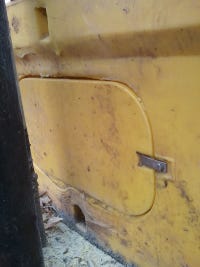January 25, 2012

You can never have too many options. That's true in a lot of cases throughout my daily life. Sometimes all of those options come with more thought than I tend to want to expend, though.
Let's say, hypothetically, you get a blast of cold winter air and find that your newly installed cattle waterer is frozen. Your electrician is sort of new at this sort of installation thing, so he got it set up, but he didn't get the thermostat set high enough to keep the water in liquid form. Your waterer is a brand you don't particularly like, but it's the only one local suppliers sell anymore, so you buy it instead of your old reliable stainless steel model that hasn't given you trouble for most of your career.
Waterers are usually not that bad to thaw out. You take a gallon milk jug and fill it with hot water from the sink. Pop the lid on your waterer, take the cover off the water valve and pour the hot water on it. Wait a moment and water begins to flow again. Replace all the stuff you took off and go about your day again.
Your new waterer doesn't play the game like that. The first gallon of hot water does nothing. The second gallon also does nothing. The valve on the water pipe coming out of the ground doesn't turn, so this baby is good and frozen. (On your previous favorite model, a second gallon was only needed on days below -30 F, and the second gallon never had to be emptied to generate water flow. One to two quarts of the second gallon got water going on that one. This new one? Frozen solid at 15 degrees ABOVE zero. Thank you, progress.)
Oh, if only there was a way that warmth could be transferred from the cattle's breakfast nook to the water pipe under the new waterer. But wait! There's this brand-new portable heater we just acquired that would be the perfect fit for this scenario!
I jumped in the cozy cab of my skid loader and headed down the road to get the new wind torch to see if it wouldn't be the perfect solution. Got that puppy all set up with power and fuel and aimed it at the bottom portion of the waterer, thanks to the handy side access door the engineers put within easy reach. A good warm breeze aimed at the waterer should warm up the ambient temp to the point of thawing it out adequately. Granted, it wouldn't be as fast as a jug of hot water on the other model of waterer, but it would be quicker than me standing on my head blowing on it to warm it up instead.
I set the heater a couple steps away from the waterer and went about my business with some other projects. No need to assemble elaborate ductwork for this job, I figured. Warmth is warmth. Why bother with guidance? Besides, a guy I know is a first-rate character and he set up some ductwork with his heater like this one. Got it all set up to thaw the frozen waterers in his barn on New Year's Eve. He made his ductwork out of bales. They tend to ignite when you blow 200-degree air through them for a while and don't stand around to watch. I wasn't going to let that happen to me, Mr. Safety.
A few minutes later, I came back to see if we had water flowing yet. Miracle of miracles, we did! But that wasn't all we had. Remember my old favorite water fountain? The stainless steel one? That was my favorite part of it. It was a rock solid performer. This new one claims to be cutting edge. You know what they make cutting edge stuff out of? Space-age polymers. Lots of great insulation value in those polymers. They are lighter than those old, heavy, stainless steel models and they can be molded into smooth shapes instead of sharp corners.
You know what those space-age polymers do when put in contact with some serious heat from a portable volcano? They morph. They morph big-time.
My cattle fountain had turned into sort of a fondue pot. The top was melting. The sides were melting. The side access door frame was drooping down like it was made of stiff cake batter.
This would require a plan of action. Step #1: Just chill. By that, I mean flip the switch, pull the power cord and kill the heat. Return the ambient  temperature in the pen to the day's more typical December conditions. If Heat + Time = Melted Fountain, subtract the heat. I think that balances the equation, but algebra was never my favorite part of math.
temperature in the pen to the day's more typical December conditions. If Heat + Time = Melted Fountain, subtract the heat. I think that balances the equation, but algebra was never my favorite part of math.
Then I should have moved to Step #2: Become a sculptor. Grab anything solid and use it to shape the wet clay (the now-liquid waterer housing) in front of you. Incidentally, your wet clay is now turning into cotton candy. As the space age polymers begin to cool, they begin to hang in loose strands like cotton candy. Since you’re not going to get wine-and-cheese crowds in the feedlot like it’s a MoMA exhibit, skip the stylistic stuff and go with function over fashion.
So I went with my own Step #2: Remove the evidence. Start pulling at anything that's where it shouldn't be and get it out of there. Load up the heater and remove it from the scene of the crime. If it's not there, it didn't cause the problem.
Then come back a couple minutes later to discover that the side access door no longer fits where it should. Yeah, it's not like the submarine hatch doesn't seal and the thing is going to take on copious amounts of water as a result of a poor seal, but that door sorta needs to shut so that cold air doesn't get in to freeze the water line. Cuz, hey, we all know how that problem gets solved, don't we?
Since your cattle have one other water source they can use, you decide to limit access to this particular option. Some time to think may help. The next day, it warms up. Much nicer weather to be working on water issues. Why, it's even sloppy in the feedlot now, thanks to the warm temps. You know what that means? You get to lie down in sloppy stuff to work on your mistake!
But there is no OFF position on the genius switch. I used an air-powered grinder, as well as a cordless model, to do some serious artwork. It bordered on plastic-surgical-quality stuff. Basically, my waterer got a facelift. Drooping lines were lifted. Excess sag was carved away. Everything was carved and filed until it started looking like the face of an early-twenty-something again. Finally, after a lot of work with the grinders and a straight edge for squareness checks, the side access door was popped into position. It held. Only minimal hammer work was required. Okay, it was majorly minimal, but it worked.
Perhaps I'll shut off that waterer during the winter and only use it when the temperature is above 50. Meanwhile, I'm going to switch to not plugging in the engine on the big screamin' diesel truck this winter. If it gets too cold to start, I'll just move the new Porta-Vesuvius into position and crank some thermals at it. Problem solved.
What could possibly go wrong?
Guy No. 2
About the Author(s)
You May Also Like






